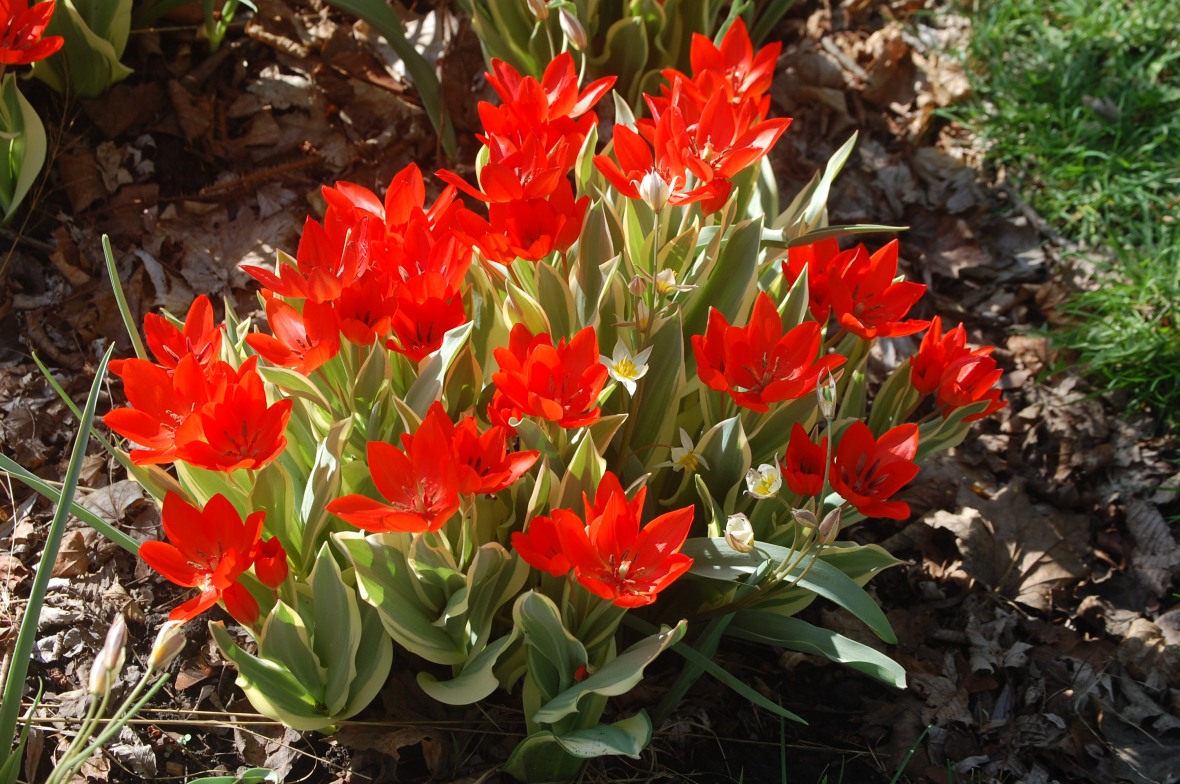Another Couple of Bulbs You Really Need
In a recent post I concluded an orgy of bulb buying by buying some more bulbs. Specifically, two bulbs which you should consider for your own garden, assuming 1) you don’t have it already; and 2) the conditions are appropriate. The two bulbs of which I speak are Tulipa praestans ‘Fusilier’ and Camassia quamash, also known as Quamash or Wild Hyacinth.

Years ago I ordered T. praestans ‘Fusilier’ but I’m pretty sure I got ‘Unicum’ instead. ‘Unicum’ looks just like ‘Fusilier’ except that it has variegated foliage.
The main thing about this Species Tulip is the color: a truly vibrant scarlet that I love. Also, it blooms fairly early in April, helping one’s springtime pulse to quicken.
Species Tulips tend to be more reliably perennial than their more refined cousins, and may even naturalize. Sadly, this is not the case with T. praestans. Even so, T. praestans is a good candidate for growing in pots, since it’s unlikely to last more than a year anyway. That’s exactly what I did with the 50 bulbs I ordered from John Scheepers.

Quamash is a native to the Pacific Northwest but it is hardy in USDA zones 4-8. It has several important virtues. First of all, there are the lovely star-shaped blue flowers that grow on upright stems about 2′ tall.
Second, Quamash is more tolerant of moist soil than most other bulbs. If happy, it will naturalize. Quamash is also rodent-resistant, so you don’t have to worry about the display of azure flowers being cancelled due to rabbit or vole attack.
And Quamash is a bulb with a good sense of timing. It blooms in late May, after most Tulips are done and there isn’t a great deal going on in the garden.
Have you grown either of these bulbs? If not, what are you waiting for?





I’ll pass on those particular tulips, only because they are no more perennial than the fancy hybrids. (That is not definite of course, since I do intend to eventually grow some of the annual sorts, but that is another story.) I still prefer the other specie that are more likely to naturalize. Quamash is not grown here outside of its range, but it somehow ended up in the garden. I seriously do not know where it came from. I might have seen it in Oregon, but I did not bring any back.
I would think your area would be too dry for Quamash.
Our region is too dry for most of what we grow here. We water everything, even so-called ‘drought tolerant’ landscaping.
I have to grow tulips in pots as they don’t like my heavy soil and barely last one winter in the ground. I have a few Quamash but haven’t bought more as I find the flowering time is so short, is it longer for you? The white ones seem to flower for longer and increase better for me.
I guess their bloom time is kind of brief.
I love the species tulips and T. praestans is lovely. Camassias are all over my garden, they seed very feely. I love them but their flowers are so fleeting.
I never thought about that for some reason, though I am very aware of the short bloom period of many Irises, for example.
I haven’t tried those beauties because I’m waiting for the squirrel convention to find a new place to call home. 🙂
Damn squirrels.
I had T. praestans ‘Fusilier’ in my Michigan garden and I loved it. You are spot on about the color; it really is electrifying. That garden was a city garden, with no deer. My present garden is unfortunately visited nightly by Bambi, so no tulips for me. I love Camassia and have had it in several Of my gardens. So far no deer have eaten it.
Very grateful that I don’t have to contend with deer. The rabbits are bad enough.
They’re beautiful but I’m rather tulip-challenged. The Quamash is lovely. Will look for it.
Tulip challenged because of noshing animals? Have you tried them in pots?
I finally ordered some tulips this weekend. Will put some in pots for extra protection from the voles and/or squirrels. Thanks.
Good luck!
I need some of those red tulips for sure. They look so chipper. I do grow the Camassia. It doesn’t naturalize here but the clumps get larger and larger. I love it. It is so pretty in the garden when it blooms before any other blues other than crocus get going.
As long as the clumps expand it’s a good investment.
Two beauties!
Agreed!
I have grown both of these for over a decade, and love them both. My tulips always come back up and bloom abundantly, despite what I am always told about them.
Nice that your tulips are reliably perennial. I wonder if you have sandy soil?
Nope. It is pretty nice rich stuff, though. I live in a neighborhood that was once the floodplain around a lake. The houses were all built before developers scraped away topsoil to sell it. We flood every time it rains but in between, we have happy plants. Of course, we didn’t know all this when we bought the house.
I ask because Tulips are supposed to do best in well drained soil. I read that Holland is such a leading grower of Tulips because of their sandy soil.
That makes sense.
I love that bright colour and am pleased to say I have planted some of these this autumn. I don’t think they are the sort with variegated foliage, as they were just labelled ‘Tulipa Praestans’. As for Camassia, I must order some quick as it is getting colder here next week! Thanks for the reminder!
You’re welcome!
It seems I am too late though… sold out wherever I look! Must make a note for next year…
“It blooms in late May, after most Tulips are done and there isn’t a great deal going on in the garden.”. ??? Many gardens have a *lot* going on in May: bearded and Siberian iris, peonies, once-blooming roses, foxgloves, columbines, geraniums, ornamental alliums… Camassias can be a great accent to these, but one of the reasons they’re not more widely grown may be that gardeners aren’t feeling a need for more flowers for that period.
Point well taken.
Camassia is great for naturalising in grass- unlike many other bulbs that do not have the strong constitution I agree about how great tulips are for naturalising in the garden(but not in grass) – provided you are a little picky about a warm sunny well drained site. I find ‘Fusilier’ rather prone to slug damage if not in full sun
We don’t have many slugs around here except in shady, wet areas.
I don’t grow bulbs anymore but I wish I’d had the Quamash when I did!
You could always make an exception for them.
Oh…..gorgeous! Look forward to seeing them in bloom!xxx
Me too!
Those tulips just jump out of the screen…I’ll look out for them. With our cold winters and hot summers tulips have more stamina than many other bulbs…do they originate from Turkey?
A swath that includes Greece, Turkey, Iran, and Central Asia.
So they can survive in the middle of Australia I guess!
They both look smashing. 🙂
My dream is a garden with lots of blooming perennials, including bulbs, but it’s not completely without prolems with our cold climate and all those little rodents from the woods and fields.
As always, thank you for your comment! Canada geese can be spotted in Finland too, at least occasionally.
Yes, we have some rodent problems too, especially rabbits and squirrels. At least we don’t have to contend with deer.
I’ve never heard of Quamash – sound perfect as it really would be nice to get something happening once the tulips finish. How long do the blooms typically last for?
I guess it is more commonly called Camassia. Blooms last 1-2 weeks, I guess.
I don’t have either of these bulbs in my garden but do enjoy seeing the fields of wild camas in bloom in the spring.
That must be gorgeous. Some day I will have to get to the PNW in May …
Hello Jason, Camassia is definitely on my list but it’s Lechlinii that I am after. I’m planning to have a thick weaving ribbon of white and blue Camassia in the new Landing Pad border. I may have missed the boat on buying bulbs this year, which is annoying, but I’ve always had this in mind for this border, the curves will be filled out by Candelabra Primula as the soil there should remain fairly moist.
That ribbon of blue and white sounds exquisite.
I have the ‘Fusilier’ here, probably thanks to you — love it! I grew the Camassia years ago in Glen Ellyn and enjoyed. It had a great first year then began to fizzle out. Not sure if that’s typical or if it was a function of increasing shade, clay, etc etc. Out here on the prairie I have Camassia scilloides which is smaller but quite lovely and has persisted about 10 years now.